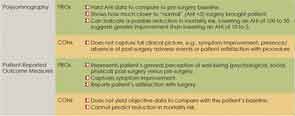Explore This Issue
February 2013Quality of Life
In treating OSA, there are measures of success beyond clinical metrics. “Physicians also have to look at how the patient feels as a result of the surgery,” said Dr. Hobson. “Patients consider the surgery successful if their symptoms are improved, if they experience less fatigue, improved daytime functioning, happier partners who are not being kept awake by snoring and, importantly, if they have not had complications as a result of the surgery.” UPPP surgery carries a risk for post-procedure adverse events, including difficulty swallowing, taste and smell disturbances, globus sensation, voice changes, persistent dry throat and nasal reflux. These discomforts can make patients regret choosing surgery, and make some physicians cautious about recommending the option.
Symptom and quality of life measures for evaluating surgical success, such as patient-recorded outcome measures (PROM), can be useful for assessing treatment effects in both the clinical and research settings. Published patient outcome data from sleep centers that include PROM feedback is more complete than reports that focus strictly on AHI improvement to determine surgical success rates.
Given the lack of consensus concerning how to best evaluate the success of OSA surgery, along with the risk of lasting and uncomfortable side effects, some physicians question the benefit of recommending the procedure. But many still see value in surgery for cases where CPAP does not deliver a solution, and encourage a more panoramic evaluation process, taking into account improvement over baseline and patient satisfaction.

Leave a Reply